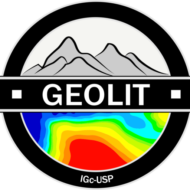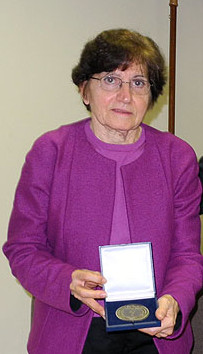
GEOLIT - Lithosphere Geosciences Research Group
About GEOLIT
History
In 1974, the then Astronomical and Geophysical Institute, today the Institute of Astronomy, Geophysics and Atmospheric Sciences (IAG), was about to be incorporated into the University of São Paulo. Already an assistant professor, Marta Silvia Maria Mantovani (photo) associates with Prof. Wladimir Shukowsky and create the Lithosphere Geophysics Laboratory. Prof. Shukowsky then idealized the acronym GEOLIT. Marta graduated from USP and, later, UNICAMP, under the supervision of César Lattes. At UNICAMP, she was one of those responsible for creating the Laboratory of Cosmic Rays and Chronology. Prof. Shukowsky, coming from the Polytechnic school, brought a technical, practical and pragmatic vision to Earth Sciences.
The GEOLIT worked on the physical aspects of large structures and planetary effects. In this context, Marta and Wladimir published works in journals such as Nature, Science, Earth and Planetary Science Letters and Gondwana Research. Examples are “Evidence From The Parana Of South Brazil For A Continental Contribution To Dupal Basalts” (DOI: 10.1038 / 322356a0), “Wood Versus Fossil Fuel For Excess Carbon Dioxide” (DOI: 10.1126 / science.190.4220.1154), “Lithosphere mechanical behaviour inferred from tidal gravity anomalies: a comparison of Africa and South America “(DOI: 10.1016 / j.epsl.2004.12.007) and” The Paranapanema Lithospheric Block: Its Importance for Proterozoic (Rodinia, Gondwana) Supercontinent Theories “(DOI: 10.1016 / S1342-937X (05) 71137-0). Over time, several significant people in Earth Sciences contributed in or with the GEOLIT, including Chris Hawkesworth, David Peate, Steve Hallinan, Marcia Quintas, Silvio de Freitas, among many others.
Between 2000 to 2010, Marta started to be less present in the laboratory due to University administrative assignments. With this,
a new group of students starts to work in the laboratory. Researchers as André Rugenski, Wanderson Pereira and Renato Cordani are highlights in the group history. In the early 2010s, two graduate students, Vanessa Biondo Ribeiro and Vinicius Louro, with the technician Roberto Zanon, started a new phase of the group focusing primarily on mineral exploration. In the second half of this decade, Marta Mantovani retired, assuming the position of Senior Teacher. Vanessa went briefly to the Federal University of Pernambuco and later became a recognized researcher at the Commonwealth Scientific and Industrial Research Organization (CSIRO) in Australia. With the end of Vinicius’ and Vanessa’s PhDs, in addition to Marta’s retirement, the laboratory is incorporated into the Gravimetry and Geomagnetism Group.
In 2018, Vinicius Louro joined as an assistant professor of Airborne Geophysics and Geotechnologies at the Institute of Geosciences of the University of São Paulo (IGc-USP). At IGc, Vinicius starts a strong partnership with professors André Pires Negrão and Rafael Rodrigues de Assis. Their research scales, continental and microscopic, although opposed, were successfully linked through geophysics. Together, the three professors created a new chapter in the Lithosphere Geophysics group history, now the Lithosphere Geosciences Group. This research group maintained the acronym GEOLIT and has Prof. Marta Mantovani as a member of honour and a kind of matron for all its researchers.
The GEOLIT Today
Headquartered at IGc-USP, the GEOLIT Group is continuously gaining importance, with the publication of articles, obtaining resources and training professionals. At the beginning of 2021, it had about 30 researchers, including professors, industry professionals and undergraduate, MSc and PhD students. They have been part of major academic projects and together with industry with IGc-USP partner groups, external groups, federal and international institutions, in addition to the industry itself. With a growing set of available equipment and state-of-the-art knowledge, the GEOLIT seeks to establish itself as an important source of high-level scientific production for the Earth Sciences.
© All Right Reserved 2021 GEOLIT
